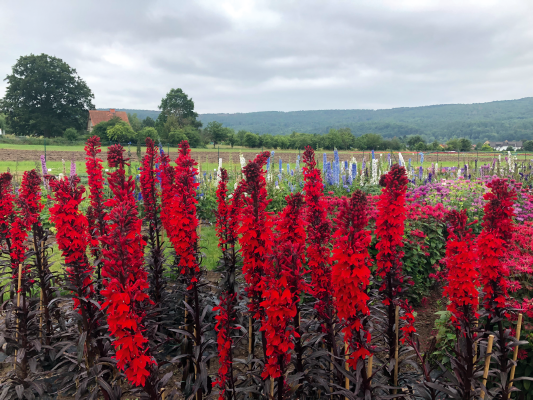
Queen Victoria
Item no.: LF0101P- FastraX perennial: First year flowering without vernalization
- Vigorous plant habit
- Intense flower color
- Perfect for beds and borders
- Possible use as cut flower
- Optimal storage: up to 6 months at 5 °C / 41 °F
- Crop Time
- Spring: 18 - 20 weeks
- Height ∅
- 30 ″ / 75 cm
- Width ∅
- 14 ″ / 35 cm
- Exposure
- Sun - Partial shade
- Seed Form
- ApeX Pelleted
- Heat Zone
- 9-2
- Hardiness Zone
- 6-10
- Best Uses
- Bedding, Cutflower, Landscape
Culture guide
Usage
Perennial for border and cottage garden, container plant, bedding, cut flower plants
Sow time
January-March for flowering in pots from July onwards, June-August for flowering in pots the following year, April-May for cut flower production outdoors
Sowing method
1 seed per plug for short day conditions
3-5 seeds per plug for long day condition, because at long day the plants do not form a leaf rosette.
Germination
Germinates in 14-20 days at 65-72 °F (18-22 °C). Light is required for germination.
Growing on
Transplant plugs after 8-9 weeks. Grow on at 60-65 °F (15-18 °C). Vernalization is not required for flower initiation. After transplant, maintain temperatures of
60-65 °F (15-18 °C) for 7-8 weeks under long days.
Media
Use a well-drained, growing substrate with 15-30 % clay, 1-1,5 kg/m³ complete balanced fertilizer, 0-3 kg/m³ slow release fertilizer (3-9 months), iron-chelate, micronutrients, pH: 6.0-7.0. Field: humus, sandy humus soils with a good drainage. Standard fertilization: 60-80 g/m² of a slow release fertilizer.
Temperature
Grow at 15-18 °C, later decrease the temperature to 10-15 °C, when the root development in pots is very good. Cultivation outdoors is possible, too. In winter indoors frost free at 3-5 °C or outdoors. Outdoors fleece cover needed. L. fulgens are very sensitive to very strong frost temperatures. In spring the plants start to grow at 15-18 °C. Cold temperatures at 10-12 °C will increase the cultivation time. A chilling period (vernalization) for flower initiation is not required.
Fertilization
Moderate-high fertilization levels are required. Fertilize the crop weekly with 150-200 ppm nitrogen (at 0 kg/m³ slow release fertilizer in substrate), using a complete balanced fertilizer. Avoid high ammonium and high nitrogen levels. Don’t fertilize after mid September. In spring fertilize with 100-150 ppm nitrogen of a complete balanced fertilizer. Prevent magnesium deficiency by applying magnesium sulphate (0,05 %) 1-2 times and in case of iron deficiency apply iron-chelate for 1-2 times. Field: If necessary according to analysis, improve the soil with 60-80 g/m² of a slow release fertilizer per year, applied in several portions.
Stage I Starts with the radicle breaking through the testa. The roots are touching the medium. Ends with fully developed cotyledons.
Stage II Starts from fully developed cotyledons. Ends with the fully developed true leaf or true leaf pair.
Stage III Starts from the fully developed true leaf or true leaf pair and ends with 80% of the young plants being marketable.
Stage IV All young plants are ready for sale and in the process of being hardened off. This stage lasts about 7 days.
The cultural recommendations are based on results from trials conducted under Central European conditions. Different conditions in other parts of the world may lead to deviations in results achieved.